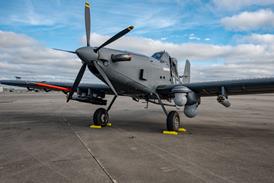Graham Warwick/SAO PAULO
EMBRAER FLEW THE prototype EMB-145 regional jet for the first time on 11 August. The Brazilian manufacturer had logged some 8h flying by the time of the official roll out and first public flight at its Sao Jose dos Campos, Brazil, plant on 18 August.
Embraer has firm orders for 18 of the 50-seat twinjets, and options for 16, but the order book is expected to swell substantially, as several of the 127 letters of intent held are scheduled to be converted to orders following the first flight.
Announced customers are Australia's Flight West Airlines (four), Transbrasil (three), Regional of France (three), Danish leasing company Eastern Trade Wings (three) and Trinidad-based BWIA International Airlines (five). Option holders include Netherlands leasing company PLM International (four).
A 13-month, 1,300h, certification flight-test programme is planned, using the prototype and three pre-series aircraft, the first of which is almost complete at Embraer, plus two ground-test airframes. Certification is planned for the third quarter of 1996, and the first four aircraft are to be delivered in the fourth quarter of 1996, all to launch customer Flight West.
The EMB-145 is being developed with several risk-sharing partners, including Gamesa of Spain, producing the wing; Enaer of Chile, building the tail; and the USA's C&D Interiors, equipping the cabin. The $14.5 million aircraft is powered by two 30kN (7,000lb)-thrust Allison AE3007A turbofans and is equipped with Honeywell Primus 2000 integrated avionics. Two versions are available, standard with a 19,300kg maximum ramp-weight and a 20,300kg extended-range variant.
The first flight was originally scheduled for January 1992, but the programme was delayed by an extensive redesign leading to the present configuration with a swept wing and tail-mounted engines and the privatisation of Embraer in December 1994. The manufacturer is now 80% owned by Brazilian and US investors and 20% owned by the Brazilian Government.
The Brazilian manufacturer followed up the roll out by revealing a 182.6 million Reais ($197.2 million) loss for the first six months of the year, blaming the results on costs incurred from restructuring before the privatisation.
Source: Flight International























